|
Apr
15
2024
|
|
Posted 1 years 241 days ago ago by Admin
|
|
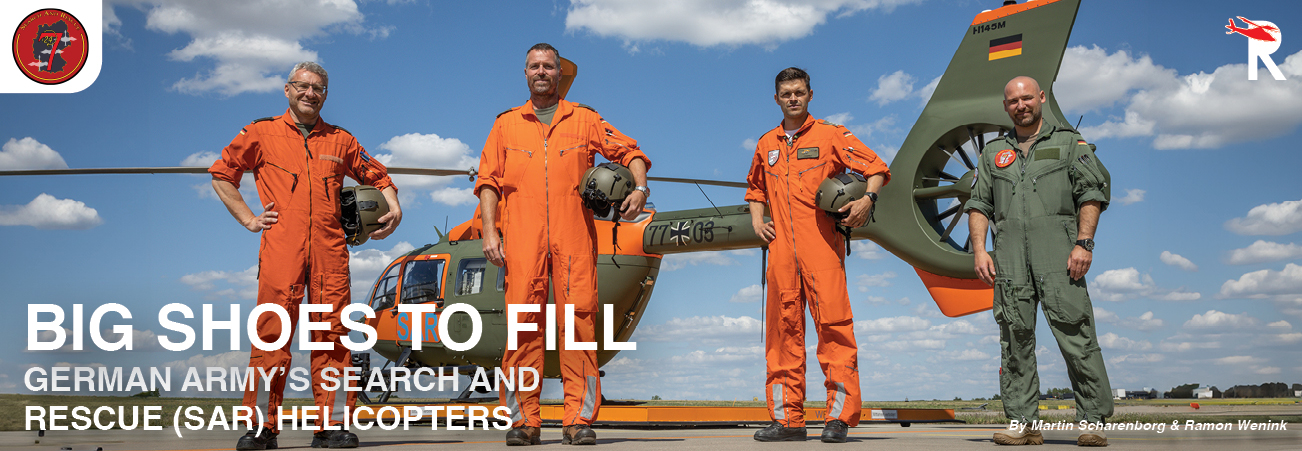
Five years after the decision was made to replace the renowned Bell UH-1D helicopter in the search and rescue role by the Airbus H145 LUH SAR, the 7th Squadron of ‘Transport Hubschrauber Regiment 30 at Niederstetten Air Base is fully operational with the new helicopter.
When the International Civil Aviation Organization (ICAO) was established in 1947, each member state was obliged to set up facilities and provide the necessary assistance in the event of an aircraft emergency over land or sea in its own territory. Following World War II, Germany was allowed to build up its own armed forces again in 1955 and joined ICAO as a member state in 1956. Preparations began to set up a dedicated search and rescue network by the ‘Bundeswehr’ (German armed forces). Although the German navy already started SAR-operations from Kiel-Holtenau in 1958; the official foundation date is considered 1 April 1959 when the 1st Rescue and Liaison Squadron was established at Faberg Air Base in northern Germany operating the Bristol 171 Sycamore helicopter and the Dornier DO-27 aircraft. Over the years a large variety of helicopters was used by the German armed forces that included the Sikorsky S-58, Vertol H-21, SaRo Skeeter, the Bell UH-1D Huey and the Westland Sea King.
Rescue Coordination Center (RCC)
Most aircraft and vessels are nowadays equipped with emergency position Indicating radio beacons (EPIRB), emergency locator transmitters (ELT) or personal locator beacon (PLB). Once such a device is triggered, a signal is sent via the 406 megahertz frequency and will be picked up by the ‘COSPAS’ and ‘SARSAT’ satellites orbiting the Earth. The satellites send the distress signal to two or more ground stations to calculate the position of the signal and is then forwarded to the French Mission Control Centre (FMCC) of COSPAS/SARSAT in Toulouse. From there, the relevant rescue coordination center (RCC) in the country responsible for the search and rescue mission is alerted.
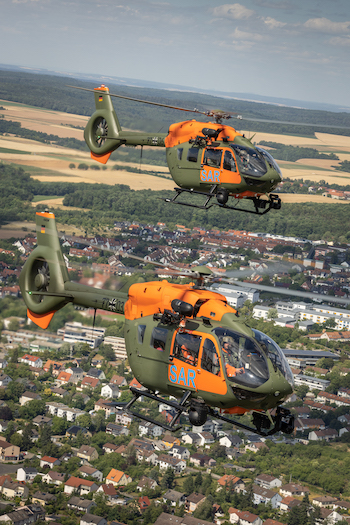
In Germany there are two Military RCCs responsible for handling these (military) distress calls. Aeronautical Rescue Coordination Centre (ARCC) Glücksburg is responsible for northern Germany and the territorial sea areas including parts of the North Sea and Baltic Sea. ARCC-SEE (translated ‘Sea’) calls in helicopters from the German navy. Until 2023, they used the Westland Sea King Mk.41 helicopter with SAR-detachments at Helgoland and Warnemünde (Hohe Düne) but this aircraft was replaced by the NTH-90 Sea Lion helicopter at these detachments. The remaining part of Germany is controlled by Rescue Coordination Centre (RCC) Münster, and is called ‘RCC-Land.’ At this location, 36 soldiers are closely monitoring air traffic in their area of responsibility and call in, when necessary, Airbus H145 LUH SAR helicopters assigned to the German Army operating from three different SAR-detachments.
The end of a legend
The German Armed Forces bought 356 Bell UH-1D helicopters that entered service from 1967. The Luftwaffe (German air force) received 132 aircraft and many of them served in the search and rescue role operating from many detachments nationwide. Over the years, many of these detachments were disbanded and taken over by civil companies like ADAC, Johanitter, and DRF.
As a result of the ‘Bundeswehr Reform 2013’ that restructured Germany's armed forces in 2013, the Bell UH-1D helicopters moved from the German air force to the army and all remaining aircraft were assigned to Transport Hubschrauber Regiment 30 (THR 30). SAR missions were also taken over from the air force; therefore, for this purpose the 7th Squadron of THR 30 was established with detachments at Nörvenich Air Base (SAR41), Holzdorf Air Base (SAR87) and at Landsberg/Penzing Air Base. The latter moved to Niederstetten in 2016 to become SAR63.
The Huey was destined to be phased by the end of 2016, but partly due to the SAR-mission and the search for a suitable successor its service life was extended for years. On 13 April 2021 the last UH-1D left SAR-service at Holzdorf Air Base and the last flight of the UH-1D in German Army service was made in June that same year.

The best helicopter for the job
In July 2013, the German Federal Ministry of Defense ordered 15 Airbus H145M LUH SOF (light utility helicopter-special operations forces) based on the EC645 T2 for the Air Force. The first aircraft entered service from 2015 and their early experiences have been highly positive partly due to high agility, modern avionics, four-axis autopilot and excellent ‘hover mode.’ “Furthermore, the NH-90 proved to be too expensive to operate for the SAR-role and too heavy to operate from certain heli-pads,” explains Major Florian, deputy commander for the 7th squadron of THR 30. He started his flying career in 1996, flying on the Bell TH-67 at Fort Rucker (renamed Fort Novosel) in Alabama followed by flying the MBB Bö-105 in Celle, Germany, before converting to the Airbus H135 at Bückeburg Air Base. At Niederstetten he flew the UH-1D and H145 LUH SAR at and accumulated 2,000 flying hours of which 800 were on the new H145 LUH SAR. Germany’s Federal Ministry of Defense decided in December 2018 to procure seven H145 LUH SAR helicopters and another H145 LUH for testing purposes. Training for the 51 pilots of the unit started almost immediately at the Airbus Helicopters Training Academy-Germany in Augsburg and Manching. The first aircraft was officially handed over at Niederstetten on 10 December 2019 and the final aircraft arrived with the unit in March 2021.
Quick Reaction Time
The main task of the unit is to assist all (military) aircraft in distress, search for overdue or crashed aircraft, and rescue aircrew and passengers. The secondary task is giving assistance to the civil German Helicopter Emergency Medical Services if a request is made from an RCC . Another important, but not to be underestimated, task is to assist during natural disasters and military exercises.
The crew of the H145 LUH SAR, consisting of two pilots and a medic, are on duty eight consecutive days for 24 hours a day at their detachment and can be in the air (during daytime) within 15 minutes after being alerted. At night the crew must be in the air within 60 minutes, but in practice the reaction time in both situations is much shorter than required.
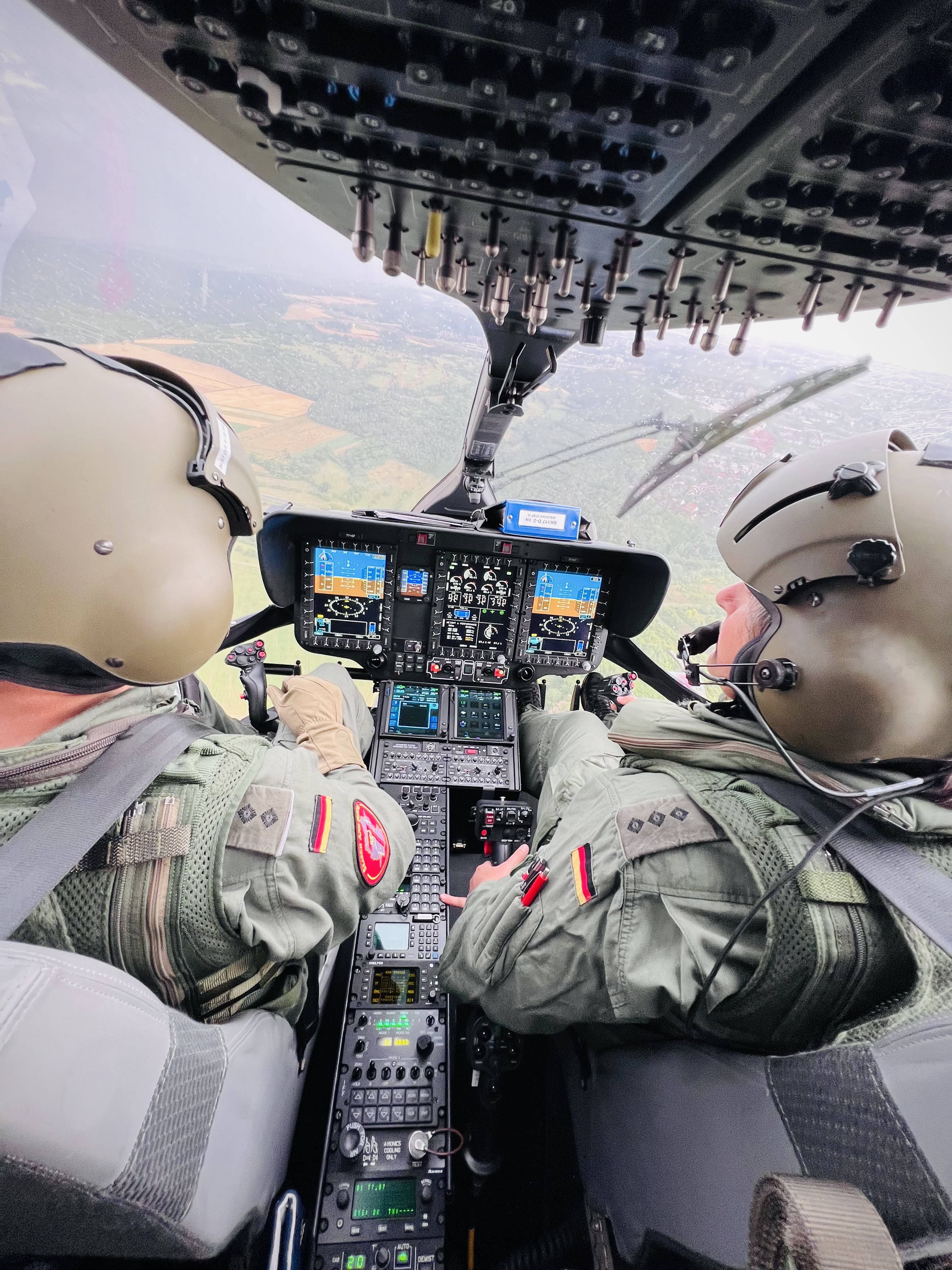
Sophisticated equipment
The H145 LUH SAR can be equipped with a wide array of equipment to support its mission. A removable L-3 Wescam MX-15 electro-optical and infrared imaging system can be installed as well as a TrakkaBeam A800 high-intensity searchlight with five color modes. The FLIR system is operated by the medic and can recognize shapes of people, equipment or vehicles/aircraft to facilitate the search. Maj. Florian says, “The Wescam is great but sometimes you can see better with your NVGs (night vision goggles) as the output of the camera is projected on just an A4 screen. With your head you can move (and look more widely,) and when you see something you can tell the operator to focus on a specific point with the camera. So, it is a combination of crew and camera to get the best results. Eyes first, camera second! In the mountains it is very difficult to operate with the FLIR during sunset as the rocks are very warm and as a result it is very hard to locate a person. When you look through the infrared, everything has one color due to the heat. So you have to switch between different filters, and therefore locating a person can become very challenging.”
Florian further explains, “The H145 LUH SAR is additionally equipped with a powerful winch with a length of 90 meters (295 feet), which can hoist two persons or a weight of 249 kilograms (548 pounds), a cargo hook capable of lifting up to 1,500 kilograms ( 3,306 pounds). Another unique feature is the CENTUM Life Seeker. The striking antennas are clearly recognizable underneath the tail-boom section. With the help of the International Mobile Subscriber Identifier (IMSI) number of a mobile phone, which is given by the authorities or police to us, we can triangulate the position of the mobile phone of the missing person. IMSI is a number that identifies the mobile phone user by its SIM card. When this number is known to us, we can trigger this mobile phone with ‘Life Seeker’ and the position pops up on our tablets.”
The SAR interior configuration is provided by Air Ambulance Technology and comprises one stretcher and seating for the medic plus an additional accompanying medical person. Medical equipment comprises a Weinmann Medical Technology ‘Medumat Transport’ respirator, a Weinmann ‘Accuvac’ suction catheter, a ‘Corpuls 3’ defibrillator and patient monitor, a Ferno scoop stretcher and three Braun ‘Space Infusomat’ infusion pumps.
More than SAR
A very important side job for the H145 LUH SAR is firefighting. With dense forests all over the country, the unit is always on high alert during the dry summer season. Throughout the year, many exercises are conducted with local firefighters, police, and private companies in effectively fighting forest fires. The H145 LUH SAR normally carries the 800 litres (211 U.S. gallons) ‘Bambi Bucket’ but also the 900 litres (237 U.S. gallons) SEMAT water tank of the Bavarian fire brigades, capable of dropping the load in just three seconds, or with a ‘spray dump’ in which the water is released in 15 to 30 seconds. The Wescam MX-15 FLIR is capable of locating underground fires and can be a valuable asset in the aftermath of a fire to see if all fires have extinguished.
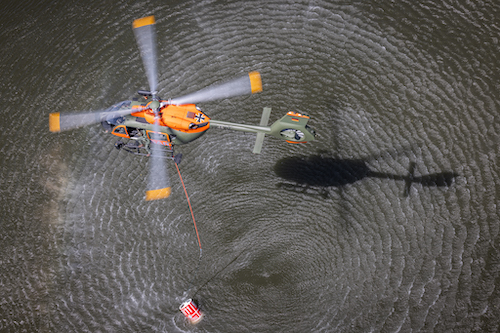
The powerful Goodrich hoist with a cable length of 90 meters (295 feet) is a huge improvement in comparison to the 45-meter hoist of its predecessor the UH-1D Huey, and is in the firefighting role of great use to transport specially trained firefighters, for example from the ‘Bergwacht’ (mountain rescue service), from and to areas that are difficult to access. These specialists are trained at the Central Training Center of the Bergwacht in Bad Tölz. Training for helicopter crews in mountainous areas is therefore key and this is done on a regular basis in the Bavarian Alps and at the Mountain Flying Center: ‘Vol en Montagne’ in Saillagouse, in the French Pyrenees.
Heavy workload
Maj. Florian says, “As you can see our squadron is heavily burdened with a lot of tasks. From the seven aircraft assigned to our unit we only have three at our disposal for special missions and training as the other three aircraft are at their SAR-detachments, and the fourth is on standby in case an aircraft change needs to be made at one of the SAR-detachments or during maintenance. However, there is an extra H145 available. This aircraft (77+08) is two-thirds of the year stationed at Manching-Ingolstadt Air Base with WTD-61 for testing and training. It lacks the striking orange SAR-doors and has no SAR-interior of equipment. In terms of training, initial training for the H145 LUH was done at the Airbus Helicopters Training Academy Germany in Augsburg and Manching. There we conducted IFR, VFR, Hoist, NVG, and the external load training, in total around 35 flying hours. Now all training on the H145 is done locally after the student comes from the IHTE (International Helicopter Training Center) in Bückeburg flying the H135. Only the theoretical part for the H145 is still done at Airbus. We additionally use … a (full flight) simulator in Frankfurt from ‘Lufthansa Aviation Training’ to relieve the training pressure in our unit. At this moment, we have two new students and they need at least one to one-and-a-half years, or around 150 flying hours, before being fully mission-qualified and ready to be sent to a SAR-detachment. A solution to reduce the workload for our unit would be the purchase of extra helicopters, but due to lack of funding that will most likely not be possible in the next few years, but we do have an H135 temporarily on loan for students and pilots to enable the mandatory flying hours.”
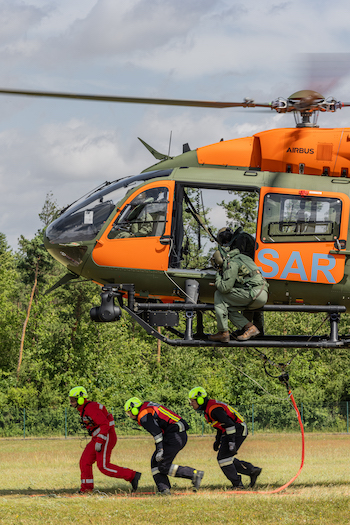
Grateful and challenging
Florian continues, “All missions during night and bad weather are challenging because we can fly when the civil HEMS are not allowed to fly anymore. During the Ahr-Tal flooding we rescued more than 100 people off roofs, balconies, out of windows, and from trees. It was one week of flying all the time and we only went back for refuelling and then straight back to the area to continue the operations. We did that with three helicopters from our squadron. We had the SAR41 from Nörvenich, the SAR63 from Niederstetten plus one additional helicopter. It was on this specific day when our mission was to assist firefighters for hoist-training when we were called back by the tower to pick up another medic to go to Cologne to refuel and then go to the Ahr-Tal for the rescue missions. There were difficult hoist missions due to small windows sometimes, but the people we rescued were very happy and you got a real good feeling after a successful rescue. I also had two missions with little babies for heart transplantation. It was a night mission with bad weather and it was very questionable to do, or not to do, the mission . It was a mission from Nörvenich to the Department of Cardiology at the University Hospital in Giessen. Afterwards, we figured out that they both survived . It was with our new helicopter. It was a pain in the ass to fly with the Huey with bad weather without any support from the helicopter, but with the new helicopter it is okay. You can do much more than with the Huey. It was the Volkswagen Beetle of the 1960s and now we drive the Mercedes S-Class!”
One team, one job
In 2022, RCC-Münster received 809 alarms, of which 597 were false. An increase of 6.2% in comparison with the year 2021. A total of 311 SAR-missions were flown by H145 LUH SAR of 7th Squadron THR30 of which 104 missions by SAR-Command/Detachment Nörvenich (SAR41), 64 by SAR-Command/Detachment Holzdorf (SAR87) and 135 by SAR-Command/Detachment Niederstetten (SAR63). Lieutenant Colonel André, head of RCC- Münster, praises the professionalism and flexibility of the search and rescue pilots: “like every military pilot, the SAR-pilots work at the highest level in an absolutely professional manner. The cooperation is exceptionally good and we are proud of the joint accomplishment of tasks. SAR: We are there always!”
READ MORE ROTOR PRO: https://justhelicopters.com/Magazine
WATCH ROTOR PRO YOUTUBE CHANNEL: https://buff.ly/3Md0T3y
You can also find us on
Instagram - https://www.instagram.com/rotorpro1
Facebook - https://www.facebook.com/rotorpro1
Twitter - https://twitter.com/justhelicopters